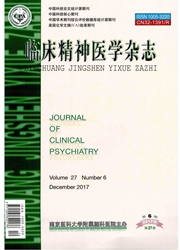

 中文摘要:
中文摘要:
目的:探讨首发抑郁症患者静息态脑磁图频谱分布特征及其与临床症状群的相关性。方法:对18例首发抑郁症患者(患者组)和22名正常对照者(正常对照组)进行静息态脑磁图扫描,采用个体化频谱分析计算方法,比较两组间各脑区δ、θ、α1、α2、α3和β各频段在感兴趣皮质区相对能量值,将有统计学差异的各脑区各频段能量值与抑郁症状严重程度进行相关分析。结果:与正常对照组比较,患者组左枕叶θ频段,右颞叶α1、左枕叶、双侧颞区α2以及双侧枕颞区α3频段能量减弱(P均〈0.05);β频段在双侧中央区、顶叶,左侧额叶、枕叶能量显著增强(P〈0.05或P〈0.01)。相关分析显示,患者组左颞叶、右枕叶α3频谱能量值与汉密尔顿抑郁量表( HAMD-17)阻滞因子分呈负相关(左颞区:r=-0.554,P=0.017;右枕区:r=-0.488,P=0.040)。结论:首发抑郁症患者头后部的快波能量增强,慢波活动减弱;快α频段能量异常或可作为患者阻滞症状评估指标之一。
 英文摘要:
英文摘要:
Objective:To explore the magnetoencephalography( MEG)spectral power feature in first-epi-sode depressed patients,and its correlation to the depressive symptoms. Method:Eighteen depressed patients and 22 age-and sex-matched healthy controls underwent whole head MEG recording. Individual spectral powers of delta,theta,alpha 1,alpha 2,alpha 3 and beta frequency bands in the regions of interest were calculated to discover the differences between the two groups. Correlation analysis was conducted between the power with sig-nificance difference and the severity of depressive symptoms according to Hamilton depression scale( HAMD-17)scores. Resuits:As compared with the controls,the powers of theta and alpha bands in patient group de-creased significantly which were summarized as follows:theta frequency band in the left occipital lobe,alpha 1 frequency band in the right temporal lobe,alpha 2 frequency band in the left occipital and bilateral temporal lobes,and alpha 3 frequency band in bilateral occipital and temporal lobes(all P〈0. 05). However,significantly increased beta activity was located in the bilateral temporal-central regions,and the left frontal-occipital lobes (P〈0. 05 or P〈0. 01). The power of alpha 3 frequency in the left temporal and right occipital lobes were neg-atively correlated with the psychomotor retardation factoritem scores( left temporal:r = -0. 554,P =0. 017;right occipital:r= -0. 448,P=0. 040). Conciusion:Enhanced fast wave power as well as attenuated slow wave activity are remarkable in first-episode depressive depressed patients. Aberrant upper alpha power may be a valuable marker to evaluate the retardation symptoms in depression.
 同期刊论文项目
同期刊论文项目
 同项目期刊论文
同项目期刊论文
 期刊信息
期刊信息
